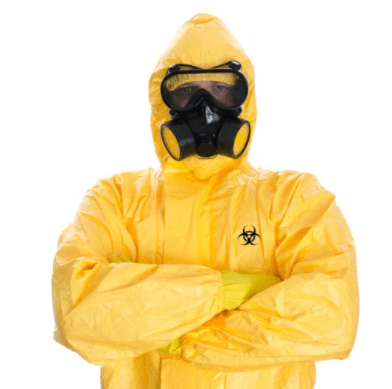Uncovering the Power of HazMat Suits: Understanding Your Protective Wear Options

A Hazmat suit provides efficient shielding against chemicals, toxins, and more dangerous forms of hazardous materials. But with all the various types of hazmat suits available on the market today, it can be hard to design one that best fits your needs and environment. To help make the process easier for you, this blog post will break down the different types of hazmat suits that can be created by manufacturing companies like Vinyl Technology so you can make an informed decision when deciding which one is right for you!
What is a Hazmat Suit and How Does it Help?
A hazmat suit, also known as a hazardous materials suit, is a type of protective clothing designed to provide protection from hazardous materials or substances. These suits are typically made from non-porous synthetic fabrics in order to provide the user with maximum protection from chemical, biological, and radioactive hazards.
They usually consist of an impermeable coverall, gloves, boots, and a hood to cover the entire head and face. The suit is designed to protect the wearer from direct contact with hazardous materials or substances that may be encountered in environments such as industrial settings or during public safety incidents.
Hazmat suits are designed to be lightweight yet durable enough to provide adequate protection against hazardous materials. The fabric used must be able to withstand exposure to corrosive substances and temperatures while providing adequate flexibility for ease of movement.
The main purpose of wearing a hazmat suit is twofold; firstly it provides physical protection against potential injuries such as skin irritation or burns caused by contact with hazardous materials. Secondly it can provide psychological reassurance that the wearer is safe from contamination by dangerous substances.
People who work in potentially hazardous environments such as those involving chemical spills or toxic waste often wear hazmat suits which offer them an additional sense of security whilst carrying out their duties.
A Breakdown of the Different Types of Hazmat Suits
Hazmat suits are a crucial part of any potential hazardous material situation. Depending on the severity of the hazardous material, different levels of protection are available. Generally speaking, there are three main categories: Level A, B, C, and D. Each level offers a different degree of protection depending on the type of hazardous material being dealt with.
Overall, hazmat suits play an important role in protecting those who may come into contact with hazardous materials in their line of work or during emergencies. Regardless of which type you choose to use, they can help keep you safe while dealing with dangerous substances and should always be used when working in potentially hazardous environments.
Level A Hazmat Suits
Level A hazmat suits are the highest level of personal protective equipment (PPE) available and are designed to provide complete protection against hazardous materials. These suits are made up of a two-piece suit – a jacket and trousers – as well as an integrated hood, boots, and gloves.
The suit is impermeable to gases, liquids, and solid particles, making it perfect for use in the most hazardous environments. The materials used in the construction of these suits are typically flame-resistant fabrics such as Nomex or Kevlar. Level A hazmat suits are used by those working with hazardous chemicals in industrial settings, medical personnel treating patients exposed to dangerous chemicals or biological agents, and first responders at natural disaster areas affected by hazardous materials like oil spills and nuclear accidents.
In addition to providing complete protection against hazardous materials, Level A hazmat suits also protect against bodily fluids like blood and virus-carrying aerosols that may be present at crime scenes or during medical treatment.
Despite their many advantages, these suits can be hot and uncomfortable to wear for long periods of time due to their tight fit and heavy fabric construction. For this reason, it’s important to ensure that workers wearing them have access to breaks where they can remove the suit so they can cool off and rest.
Level B Hazmat Suit
Level B hazmat suits are typically used by medical professionals, fire fighters, chemical handlers and industrial workers who are exposed to hazardous materials on a regular basis. For example, a doctor may use a Level B hazmat suit when treating patients with infectious or airborne diseases.
Firefighters may use these suits to protect themselves from dangerous chemicals or other hazards present during firefighting operations. Chemical handlers may also wear Level B hazmat suits while mixing or transferring potentially hazardous substances. Industrial workers often use Level B hazmat suits as well because they can protect them from toxins and dust particles that can be released during manufacturing processes.
Level C Hazmat Suit
Level C Hazmat suits are the most common type of protective apparel used in hazardous material operations. Level C hazmat suits provide a minimum amount of protection against these hazards.
The suit is typically made from multiple layers of fabric, often including fire-resistant material, which is then sealed with a barrier layer for additional protection. The suit also includes gloves, boots, and an airtight hood or full face mask with an integrated filter system that allows the user to breathe safely in contaminated environments.
Level C hazmat suits are used primarily by hazardous materials responders, such as firefighters and emergency medical technicians who specialize in dealing with chemical spills or other hazardous incidents. These responders may use Level C hazmat suits when responding to chemical fires or responding to suspected biological threats. Hazmat responders may also use Level C suits when working within a confined space or performing decontamination procedures on hazardous materials at a scene.
Level D Hazmat Suit: Who Would Use This?
This type of hazmat suit offers the least protection. It generally consists of a chemical-resistant one-piece garment, an air-purifying respirator (APR) to filter particles from the air, and safety goggles. This type of suit is typically used for minor spills and cleanup operations. It’s also frequently seen as a uniform-style suit worn in day-to-day operations that might benefit from a small amount of protection.
Level D hazmat suits are most commonly used by workers who may be exposed to hazardous substances in the course of their jobs. This includes workers involved in cleaning up minor spills, handling hazardous waste, and performing other activities that could pose a risk to the safety of personnel. In general, Level D suits are often worn in industries such as construction, mining, oil and gas, and manufacturing.
What are the different Emergency Response Levels?
In addition to regular, predictable exposure to hazardous materials in fields like medicine and industrial waste, hazmat suits are also used in emergencies. Every type of emergency has a response level, a classification used to determine the scale of an emergency situation.
It is a way for emergency personnel to communicate the type and severity of an incident so that appropriate resources, like hazmat suits, can be deployed. There are several levels of response, ranging from Level 1 (smallest) to Level 5 (largest).
Level 1 is a general call-out for small incidents such as medical aid, false alarms, and vehicle accidents. This is considered the lowest level of response and requires minimal resources, such as two or three ambulances or police cars.
Level 2 represents more serious situations in need of additional staff and vehicles. These could include fires, hazardous material spills, civil disturbances, or rescue operations at height or in confined spaces. The number of personnel responding to this level depends on the nature and size of the incident but can range from six to twelve people with three or four vehicles.
The highest two levels of response involve large-scale emergencies such as natural disasters, major industrial accidents, weapons of mass destruction threats, and catastrophic incidents requiring multiple agencies from different jurisdictions.
Finally, Level 5 is reserved for catastrophic events requiring massive resources from many different agencies within a wide geographic area. This type of situation may require hundreds of responders utilizing many specialized assets such as helicopters, ships, and military assets. As these types of incidents are rare but have potential to cause massive destruction and loss of life they must be prepared for with careful preplanning backed by considerable resources.
Hazmat Suit Manufacturer Vinyl Technology
In 1984, Vinyl Technology was hand-picked to manufacture the famous DPE (demilitarization protection ensemble), an early and revolutionary development in hazmat suit technology.
In the mid 1990’s, the United States launched a chemical demilitarization mission to rid its stockpiles of dangerous weapons. As such, there was an urgent need for a reliable contractor with an established track record in providing high-quality services who could manufacture and supply custom made single-use protective suits that were air tight and resistant against hazardous chemicals. The success of this mission relied upon finding the right partner; one whose products would guarantee safety for those involved by keeping them secure from any potential risks posed by their environment.
All of our products are rigorously tested for compliance with standards set by relevant government agencies as well as industry groups like NFPA and ASTM International. Vinyl Technology Inc is a berry compliant trusted co-manufacturing partner for those who need durable protective garments that will stand up to any challenge.

